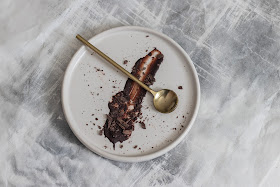Napokon sam se preselila na Mjesec. Nisam nikad mislila da će biti ovoliko lijepo. Jedni divni ljudi, dragi prijatelji koji su me nesebično prihvatili na cimerovanje, osim dobrog srca i slatke kuće imaju i prekrasan vrt pun svakakvog voća i povrća. Nekidan sam radila miso juhu od domaćeg povrća (možda se dogodi neki recept uskoro), a danas crumble - predlažem novu hrvatsku riječ "mrvuljak" - od domaćih jabuka, krušaka i rabarbare. Bio je toliko dobar da je nestao u trenu. Sva sreća pa imamo toliko jabuka i krušaka da ga mogu raditi svaki dan do zime, a i dulje (šalim se, napravit ću ocat).
Ako čitate ovaj blog zbog zdravlja, budite upozoreni: ovakvi kolači su poslastica za posebne prilike. Nije važno je li to sestrin rođendan ili trenutak proždrljivosti koji vas uhvati jednom mjesečno; ulje i brašno su slasna kombinacija, ali, bez obzira na to što se ovdje radi o pirovom brašnu i kokosovom ulju, nisu nešto što želite jesti svakodnevno i u velikim količinama ako ste biljnu prehranu izabrali kako biste si poboljšali zdravlje. Ipak - fino je, umjerenost je još uvijek majka, a uživanje nije uživanje ako vas prati grižnja savjesti. Zato slobodno bezbrižno po svoj komad, ili krišku ipo... ovoga.
što/
[za tijesto]
1 šalica pirovog brašna iz cijelog zrna
1 šalica bijelog pirovog brašna
1/2 šalice kokosovog šećera
1/2 šalice kokosovog ulja
1/2 šalice maslaca od badema*
3-5 jušnih žlica bademovog mlijeka
1 prstohvat mljevenog cimeta
1 prstohvat mljevenog muškatnog oraščića
2 jušne žlice mljevenog rogača**
[za punjenje]
2 velike jabuke
1 velika kruška
1 velika lisna stapka rabarbare
2/3 šalice oraha
2 jušne žlice mljevenog rogača**
1 čajna žličica mljevenog cimeta
1/3 šalice kokosovog šećera
*bilo bi dobro maslac od badema zagrijati na temperaturu nešto višu od sobne kako bi bio što mekši, jer ćete ga tako najbolje umiješati u tijesto
**koristite grubo mljeveni rogač, a ne rogač u prahu
kako/
Prosijte svo brašno kroz grubo sito ili cjedilo. Dodajte kokosov šećer, cimet, muškatni oraščić i mljeveni rogač. Umiješajte rastaljeno kokosovo ulje i bademov maslac pjenjačom. Dodajte nekoliko žlica bademovog mlijeka, samo onoliko koliko je potrebno da se tijesto lako zamijesi. Zamijesite tijesto kako bi se svi sastojci dobro pomiješali, te ga podijelite na dva jednaka dijela. Jednu polovicu utisnite u kalup za pečenje u tankom sloju. Narežite jabuke, krušku i rabarbaru na tanke komade površine oko 1 cm^
2 i stavite u zdjelu. Sameljite orahe i dodajte ih u zdjelu s voćem. Dodajte cimet, kokosov šećer i rogač i dobro promiješajte. Ravnomjerno rasporedite voćni sloj u kalup preko utisnutog tijesta. Ostatak tijesta razmrvite rukama u rahli sloj koji ravnomjerno prekriva voće i sve skupa pospite cimetom. Pecite 40-45 minuta na 175 °C.
[ENG]
apple, pear and rhubarb crumble
I finally moved to the Moon. I never imagined it to be so beautiful. Along with kind hearts and a cozy house, these wonderful people and dear friends who have selflessly welcomed me to their home, have a beautiful garden full of homegrown fruits and vegetables. The other day I made a miso soup from homegrown vegetables (a recipe for that might happen in the near future), and today was a perfect day for a spelt flour crumble made with homegrown apples, pears and rhubarb that the garden is still full of. It was really delicious and disappeared in a second. Luckily, with the amount of apples and pears that we have, I could probably bake a new one every day up until the winter comes, or even longer (although I will probably just make some vinegar instead).
If you are reading this blog because of health, be warned: this type cake is a treat for special occasions. It doesn't matter if it is your sister's birthday or a moment of gluttony that you face once a month; oil and flour can make a tasty combination, but even though we're talking about spelt flour and coconut oil here, they are not something you would fancy eating on a daily basis and in big quantities if you chose plant-based diet to improve your health. Sill - it is tasty, moderation is the key when it comes to treats, and enjoyment is not enjoyment if it makes you feel guilty. So don't worry and allow yourself an opportunity to just carelessly enjoy... this delicious thing.
what/
[for the dough]
1 cup whole grain spelt flour
1 cup white spelt flour
1/2 cup coconut blossom sugar
1/2 cup coconut oil
1/2 cup almond butter*
3-5 tbsp almond milk
1 pinch ground cinnamon
1 pinch ground nutmeg
2 tbsp ground carob**
[for the filling]
2 large apples
1 large pear
1 large rhubarb stalk
2/3 cup walnuts
2 tbsp ground carob**
1 tsp ground cinnamon
1/3 cup coconut blossom sugar
*almond butter should be heated just a bit above the room temperature to soften so it will be easier to mix into the dough
**use somewhat coarsely ground carob rather than fine carob powder
how/
Sift all the flour through a coarse sieve or a strainer. Add in the coconut sugar, cinnamon, nutmeg and ground carob. Whisk in melted coconut oil and almond butter, and add just a couple of tablespoons of almond milk to make it possible to knead. Knead the dough to mix everything properly and divide it into two equal parts. Press one part of the dough into a baking mould in a thin layer. Cut the apples, pear and rhubarb into small and thin pieces and put into a bowl. Grind the walnuts and add them to the bowl. Sprinkle with cinnamon, add the coconut sugar and ground carob and mix everything to combine. Spread this mixture evenly on top of the dough that you have pressed into the mould. Crumble the other half of the dough on top of the fruit layer and sprinkle with some cinnamon and carob. Bake the crumble on 175 °C for 40-45 minutes.





















































